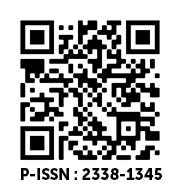Physicochemical and Sensory Analysis of Cocoa-Coffee Blend Drink Using the Check-All-That-Apply (CATA)
DOI:
https://doi.org/10.36782/apjsafe.v11i1.209Keywords:
Arabica coffee, cascara, chocolate drinks, check-all-that-apply (CATA), physicochemical profiles, steviaAbstract
Chocolate drinks are widely consumed due to their rich flavor and polyphenol content. Previous research has highlighted the flavor richness and high polyphenol content of Arabica coffee. This study aims to examine the effects of adding Arabica coffee on the physical characteristics and sensory profiles of chocolate drinks. The composition of the chocolate drinks used in this study includes fermented cocoa powder, Java Preanger Arabica coffee powder, Cascara Arabica, and stevia sweetener. Physicochemical analysis methods encompass color testing, pH measurement, and total soluble solids (TSS) determination. The five tested formulations resulted in a slightly dark yellowish-red color, with pH values ranging from 5.82 ± 0.10 to 6.22 ± 0.08, and TSS content ranging from 5.17 ± 0.76 to 5.90 ± 0.46. In addition to physicochemical analysis, sensory analysis was conducted using the Check-All-That-Apply (CATA) method facilitated by XLSTAT. Although no formulations matched the ideal product, the most preferred formulation consisted of 80% cocoa and 20% coffee, attributed to its sweet flavor. With lower percentages of coffee addition, attributes such as chocolate flavor, sweetness, caramel flavor, and milk flavor became more prominent in the chocolate drinks.
Downloads
References
Addinsoft. (2022). CATA Check-All-That-Apply Analysis Tutorial in Excel. Addinsoft. https://help.xlstat.com/6491-cata-check-all-apply-analysis-tutorial-excel
Alexi, N., Nanou, E., Lazo, O., Guerrero, L., Grigorakis, K., & Byrne, D. v. (2018). Check-All-That-Apply (CATA) with Semi-trained Assessors: Sensory Profiles Closer to Descriptive Analysis or Consumer Elicited Data? Food Quality and Preference, 64, 11–20. https://doi.org/10.1016/j.foodqual.2017.10.009
Anoraga, S. B., Wijanarti, S., & Sabarisman, I. (2018). Pengaruh Suhu dan Waktu Pengepresan terhadap Mutu Organoleptik Bubuk Kakao sebagai Bahan Baku Minuman Coklat. CEMARA, 15(2), 20–28.
Aprotosoaie, A. C., Luca, S. V., & Miron, A. (2016). Flavor Chemistry of Cocoa and Cocoa Products-An Overview. Comprehensive Reviews in Food Science and Food Safety, 15(1), 73–91. https://doi.org/10.1111/1541-4337.12180
Ares, G., & Jaeger, S. R. (2015). Check-all-that-apply (CATA) Questions with Consumers in Practice: Experimental Considerations and Impact on Outcome. In Rapid Sensory Profiling Techniques and Related Methods: Applications in New Product Development and Consumer Research (pp. 227–245). Elsevier Inc. https://doi.org/10.1533/9781782422587.2.227
Aribah, S. al, Sanjaya, A. P., Muhammad, D. R. A., & Praseptiangga, D. (2020). Sensorial and Physical Properties of Chocolate Beverage Prepared Using Low Fat Cocoa Powder. AIP Conference Proceedings, 2219. https://doi.org/10.1063/5.0003435
Ashwell, M. (2015). Stevia, Nature’s Zero-calorie Sustainable Sweetener: A New Player in The Fight Against Obesity. Nutrition Today, 50(3), 129–134. https://doi.org/10.1097/NT.0000000000000094
Belščak-Cvitanović, A., Benković, M., Komes, D., Bauman, I., Horžić, D., Dujmić, F., & Matijašec, M. (2010). Physical Properties and Bioactive Constituents of Powdered Mixtures and Drinks Prepared with Cocoa and Various Sweeteners. Journal of Agricultural and Food Chemistry, 58(12), 7187–7195. https://doi.org/10.1021/jf1005484
Bexiga, F., Rodrigues, D., Guerra, R., Brázio, A., Balegas, T., Cavaco, A. M., Antunes, M. D., & Valente de Oliveira, J. (2017). A TSS Classification Study of ‘Rocha’ Pear (Pyrus communis L.) Based on Non-Invasive Visible/near Infra-red Reflectance Spectra. Postharvest Biology and Technology, 132, 23–30. https://doi.org/10.1016/j.postharvbio.2017.05.014
Bicho, N. C., Leitão, A. E., Ramalho, J. C., de Alvarenga, N. B., & Lidon, F. C. (2011). Identification of Nutritional Descriptors of Roasting Intensity in Beverages of Arabica and Robusta Coffee Beans. International Journal of Food Sciences and Nutrition, 62(8), 865–871. https://doi.org/10.3109/09637486.2011.588594
Castro-Alayo, E. M., Idrogo-V Asquez, G., Ul Siche, R., & Cardenas-Toro, F. P. (2019). Formation of Aromatic Compounds Precursors during Fermentation of Criollo and Forastero Cocoa. Heliyon, 5(1), 1157. https://doi.org/10.1016/j.heliyon.2019
DePaula, J., Cunha, S. C., Cruz, A., Sales, A. L., Revi, I., Fernandes, J., Ferreira, I. M. P. L. V. O., Miguel, M. A. L., & Farah, A. (2022). Volatile Fingerprinting and Sensory Profiles of Coffee Cascara Teas Produced in Latin American Countries. Foods, 11(19), 3144. https://doi.org/10.3390/foods11193144
Dogan, M., Aslan, D., Aktar, T., & Goksel Sarac, M. (2016). A Methodology to Evaluate the Sensory Properties of Instant Hot Chocolate Beverage with Different Fat Contents: Multi-criteria Decision-making Techniques Approach. European Food Research and Technology, 242(6), 953–966. https://doi.org/10.1007/s00217-015-2602-z
Dogan, M., Toker, O. S., Aktar, T., & Goksel, M. (2013). Optimization of Gum Combination in Prebiotic Instant Hot Chocolate Beverage Model System in Terms of Rheological Aspect: Mixture Design Approach. Food and Bioprocess Technology, 6(3), 783–794. https://doi.org/10.1007/s11947-011-0736-y
Jaywant, S. A., Singh, H., & Arif, K. M. (2022). Sensors and Instruments for Brix Measurement: A Review. In Sensors (Vol. 22, Issue 6). MDPI. https://doi.org/10.3390/s22062290
Joel, N., Pius, B., Deborah, A., & Chris, U. (2013). Production and Quality Evaluation of Cocoa Products (Plain Cocoa Powder and Chocolate). https://doi.org/10.5251/ajfn.2013.3.1.31.38
Mazo Rivas, J. C., Dietze, M., Zahn, S., Schneider, Y., & Rohm, H. (2018). Diversity of Sensory Profiles and Physicochemical Characteristics of Commercial Hot Chocolate Drinks from Cocoa Powders and Block Chocolates. European Food Research and Technology, 244(8), 1407–1414. https://doi.org/10.1007/s00217-018-3054-z
Meyners, M., & Castura, J. C. (2014). Check-All-That-Apply Questions. In P. Varela & G. Ares (Eds.), Novel Techniques in Sensory Characterization and Consumer Profiling (1st ed., pp. 190–221). CRC Press. https://doi.org/10.1201/b16853-12
Muktiningrum, T. A., Fauza, G., Ariviani, S., Muhammad, D. R. A., & Affandi, D. R. (2022). Sensory Profile Analysis of Chocolate Drinks Using Quantitative Descriptive Analysis (QDA). In E. Yanase, I. Tewfik, & S. Radu (Eds.), International Food Conferences (IFC 2021) (Vol. 344, p. 04005). EDP Sciences. https://doi.org/10.1051/e3sconf/202234404005
Oliveira, D., Antúnez, L., Giménez, A., Castura, J. C., Deliza, R., & Ares, G. (2015). Sugar Reduction in Probiotic Chocolate-flavored Milk: Impact on Dynamic Sensory Profile and Liking. Food Research International, 75, 148–156. https://doi.org/10.1016/j.foodres.2015.05.050
Peixoto, R. R. A., Devesa, V., Vélez, D., Cervera, M. L., & Cadore, S. (2016). Study of The Factors Influencing the Bioaccessibility of 10 Elements from Chocolate Drink Powder. Journal of Food Composition and Analysis, 48, 41–47. https://doi.org/10.1016/j.jfca.2016.02.002
Safrijal, H., Widayat, H. P., & Jaya, R. (2021). Hedonic Attributes Evaluation of Mixed Arabica Coffee-Cocoa Beverages. IOP Conference Series: Earth and Environmental Science, 667(1). https://doi.org/10.1088/1755-1315/667/1/012065
Seninde, D. R., & Chambers, E. (2020). Coffee Flavor: A Review. Beverages, 6(3), 1–25. https://doi.org/10.3390/beverages6030044
Sunarharum, W. B., Williams, D. J., & Smyth, H. E. (2014). Complexity of Coffee Flavor: A Compositional and Sensory Perspective. Food Research International, 62, 315–325. https://doi.org/10.1016/j.foodres.2014.02.030
Tournier, C., Sulmont-Rossé, C., & Guichard, E. (2007). Flavour Perception: Aroma, Taste and Texture Interactions. Food Global Science Books, 1(2), 246–257. https://hal.inrae.fr/hal-02823959








